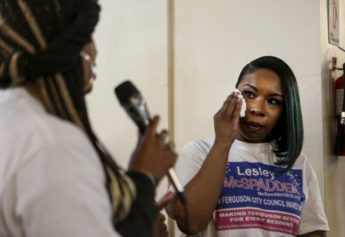
Ever since the nation elected its first Black president, it seems the topic of racism in America has become a primary topic of the national conversation.
According to Bridges, the most disturbing part of those discussions is the fact that she isn’t seeing much of a difference from today’s allegedly “post-racial” America and the country she helped change back in the 1960s.
“You almost feel like you’re back in the ‘60s,” Bridges told the Associated Press. “The conversation across the country, and it doesn’t leave out New Orleans, is that schools are reverting back…We all know that there are schools being segregated again.”
At the age of 6, Bridges was a pioneer in the desegregation of schools as she became the first Black student to attend an elementary school in New Orleans that was previously only for white students.
The role of the first Black student wasn’t an easy one. Bridges was constantly facing serious threats and one woman promised to poison the young girl.

Eventually, white parents had their children pulled from the school and teachers refused to return.
While Black students today certainly won’t need U.S marshals to lead them into the classrooms, they are still being faced with schools that seem to be divided along racial lines.
William Frantz, the public school that Bridges herself once attended, is now 97 percent Black.
Most of the white students in New Orleans were placed in private schools and sufficient funding for many of the public schools seems to be a thing of the past.
It’s a problem that has persisted for decades and Bridges doesn’t understand why lawmakers are unable to do something about it.
“How did we integrate schools back in the 1960s?” she asked. “If those people did it back then, I can’t understand why we can’t do it today for the betterment of a community or for a society.”
Bridges latest comments aren’t the first time that modern day America has been compared to pre-Civil Rights days.
Images of the militarized police forces in Ferguson, Missouri, after the death of 18-year-old Michael Brown also sparked the same comparisons.
Side-by-side images of protesters rallying in support of the slain teen and crowds of Black protesters marching during the Civil Rights movement surfaced all over the web.
Images of the incredible amounts of force police used against these protesters were also compared to the way officers were brutally attacking Civil Rights protesters back in the 60s.
Then there was one image that went viral almost immediately that exemplified Bridges’ own opinion about what the key to a more integrated society is – the children.
During the Ferguson protests, an image of a white child holding up a sign that read “My friends deserve to feel as safe and respected as I do” hit the web. Beside this child was his Black friend.
“Kids really don’t care about what their friends look like,” Bridges said. “Kids come into the world with clean hearts, fresh starts. If we are going to get through our differences, it’s going to come through them.”



